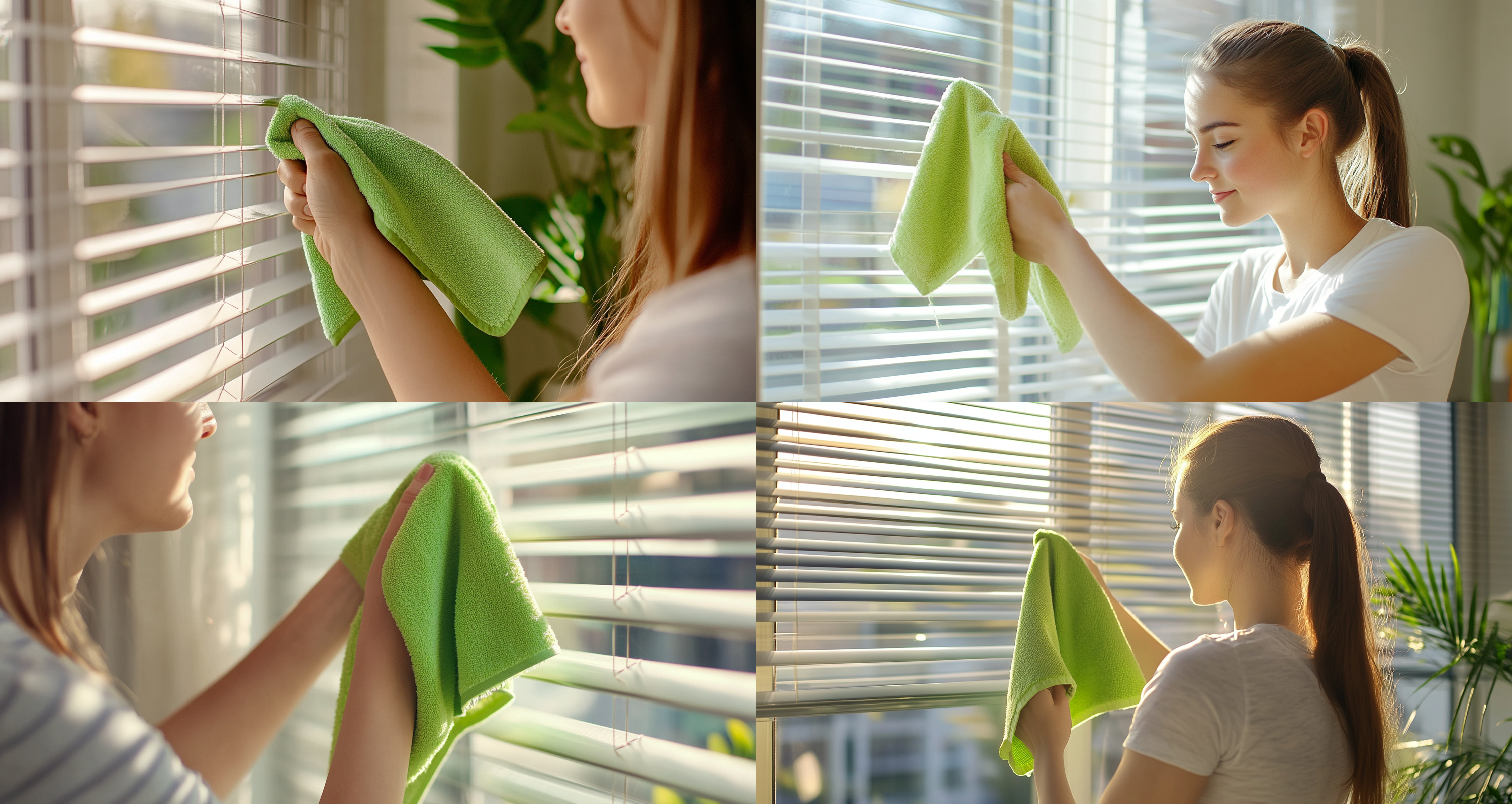Cleaning window blinds is often one of those household tasks we put off as long as possible. They gather dust, trap allergens, and are notoriously tedious to clean—especially if you think you have to take them down. But what if we told you there’s a straightforward, efficient way to clean your blinds that doesn’t require removing them from the wall?
Whether you’re dealing with horizontal aluminum blinds, vertical vinyl slats, or faux wood window treatments, this guide will walk you through how to clean your blinds in the most effective and hassle-free way possible. Keeping your blinds dust-free not only improves the look of your home, but also contributes to a healthier indoor environment, especially for those prone to allergies or asthma.
Why You Should Clean Your Blinds Regularly
Blinds are a dust magnet. Each slat provides a perfect horizontal surface where dust, pet hair, pollen, and even cooking grease can settle. Over time, this buildup doesn’t just look bad—it can impact your health and indoor air quality.
Benefits of keeping your blinds clean:
-
Reduces allergens and irritants in the home
-
Enhances the overall appearance of your windows
-
Prevents long-term staining or damage
-
Keeps your window treatments in good working condition
-
Promotes better airflow when windows are open
Most experts recommend cleaning blinds at least twice a year, with quick maintenance in between.
Preparation: What You’ll Need
Before diving into the process, gather your supplies. Having everything on hand will streamline the process and save time.
Essential Tools:
-
Old sock or microfiber cloth
-
Handheld vacuum (optional)
-
Specialized blind duster (optional)
-
Warm water
-
Liquid dish soap
-
Bucket or bowl
-
Clean microfiber cloth
-
Optional: white vinegar for extra cleaning power
💡 Tip: Use gloves if you’re sensitive to cleaning agents or dealing with heavily soiled blinds.
Step-by-Step Blind Cleaning Process
Cleaning your blinds can be broken down into two main stages: dry dusting and wet cleaning. Both are essential to remove the layers of debris effectively without making a bigger mess.
1. Initial Dusting
Removing surface dust is critical before introducing moisture, which can turn dry dust into streaky grime.
Choose your preferred method:
-
Sock method: Slip an old sock over your hand, dip it slightly in clean water (optional), and run your hand across each slat.
-
Microfiber cloth: Wipe slats gently to capture dust.
-
Handheld vacuum: Use a soft brush attachment to suck up dust.
-
Blind duster tool: These tools often have multiple prongs to clean several slats at once.
Make sure to close the blinds one way, clean them, then reverse the slats to get the other side.
2. Preparing the Cleaning Solution
Once the surface dust is gone, it’s time to deal with any residue, stains, or built-up grime.
How to make the solution:
-
Fill a bucket or bowl with warm water
-
Add a few drops of liquid dish soap
-
For extra power, add a splash of white vinegar (optional)
-
Mix gently until you have a mild, soapy solution
Avoid harsh chemicals, which can discolor or damage certain materials like faux wood or aluminum.
3. Wet Cleaning Method
This step is where the deep cleaning happens. It’s effective on most horizontal and vertical blinds—as long as they are not fabric or cloth-based.
Instructions:
-
Dip your clean microfiber cloth in the soapy solution.
-
Wring it out thoroughly. It should be damp, not dripping.
-
Gently wipe down each slat, one at a time.
-
Rinse and wring your cloth regularly as it collects dirt.
-
Work systematically from top to bottom to avoid dripping onto already-cleaned areas.
For vertical blinds:
-
Hold the base of the slat in one hand while wiping down from top to bottom with your other.
-
This prevents pulling or warping the slats.
Important Notes
Not all blinds are created equal. It’s important to understand what materials you’re working with to prevent damage.
What to avoid:
-
Don’t soak the blinds unless they’re labeled as washable.
-
Avoid excess water—moisture can warp wooden and faux wood blinds.
-
Never scrub aggressively; this can remove coatings or damage fabric-backed slats.
Materials that respond well to this method:
-
Aluminum blinds
-
Vinyl or PVC blinds
-
Faux wood blinds
Materials to handle differently:
-
Fabric blinds or shades should be spot-cleaned or vacuumed using upholstery attachments.
-
Wood blinds should be cleaned with a dry or slightly damp cloth and never soaked.
Drying the Blinds
Once you’ve cleaned all the slats, it’s important to dry them properly to avoid water spots or streaks.
Drying options:
-
Wipe each slat with a dry microfiber cloth
-
Use a fan to speed up air drying
-
Open nearby windows to improve ventilation
💡 Drying is especially important for wooden or faux wood blinds to prevent water damage or warping.
How to Clean Different Types of Blinds
Let’s break it down by type so you can adapt your cleaning method accordingly.
Venetian Blinds (Aluminum, Vinyl, Faux Wood)
-
Follow the standard cleaning process.
-
Be gentle on older or sun-damaged slats that may be brittle.
Vertical Blinds
-
Support each slat as you clean to avoid detachment.
-
Clean from top to bottom using a sock, microfiber cloth, or sponge.
Wooden Blinds
-
Dust frequently with a dry microfiber cloth.
-
Use a wood cleaner or polish if needed—never water.
Fabric Blinds or Roman Shades
-
Vacuum with a soft upholstery brush attachment.
-
Spot clean with fabric cleaner or a water-and-vinegar solution.
Pro Tips for Easier Maintenance
Cleaning blinds doesn’t have to be a major production every time. With a few simple habits, you can keep your blinds looking fresh between deep cleans.
Maintenance hacks:
-
Wipe blinds down with a dry microfiber cloth every 2–4 weeks.
-
Use a Swiffer duster or blind brush for quick touch-ups.
-
Run an air purifier to reduce dust buildup.
-
Keep windows closed during windy days to limit dust influx.
For allergy sufferers:
-
Cleaning blinds regularly can reduce exposure to dust mites and pollen.
-
Consider installing hypoallergenic window coverings in bedrooms or living areas.
Deep Cleaning Alternative: Bathtub Soak
For plastic or vinyl blinds that are extra grimy or sticky, a bathtub soak can work wonders.
Instructions:
-
Remove blinds carefully from the window.
-
Fill your bathtub with warm water and a few drops of dish soap.
-
Add 1 cup of white vinegar for tough grime.
-
Let the blinds soak for 15–30 minutes.
-
Wipe each slat with a sponge or cloth.
-
Rinse with clean water and lay on towels to dry.
⚠️ Avoid this method for wooden or fabric blinds.
What to Avoid When Cleaning Blinds
A few cleaning practices can do more harm than good. To avoid damaging your window treatments, steer clear of the following:
-
Soaking wooden blinds
-
Using abrasive brushes or scrubbers
-
Applying bleach or harsh chemicals
-
Allowing water to pool on slats
-
Ignoring metal components that could rust
When in doubt, test a small area before cleaning the entire surface.
Storage and Protection Tips
After cleaning, consider additional steps to protect your blinds from dirt, dust, and damage.
Protective practices:
-
Apply anti-static spray to repel dust.
-
Keep windows closed during construction or windy weather.
-
Avoid smoking indoors—tobacco smoke causes yellowing.
-
Clean window sills regularly to minimize upward dust drift.
If you live in a particularly dusty area, you might want to consider roller shades or curtains that are easier to wash frequently.
How Often Should You Clean Your Blinds?
The answer depends on your environment and lifestyle. However, as a general rule:
| Room Type | Frequency |
|---|---|
| Living Room | Every 2–3 months |
| Kitchen | Monthly (grease buildup) |
| Bedroom | Every 4–6 months |
| Bathroom | Every 2 months |
| Pet Areas | Monthly |
Quick monthly maintenance prevents buildup and makes deep cleaning easier.
Final Thoughts
Cleaning blinds doesn’t have to be the chore we dread. With the right approach and a few simple tools, you can efficiently clean your blinds without even removing them from the window. By incorporating routine maintenance and using the correct methods for each type of blind, you can keep your home cleaner, healthier, and more comfortable.
In summary:
-
Dust first, then use a damp cloth for deeper cleaning.
-
Choose your cleaning tools based on your blind material.
-
Avoid excess water—especially on wood blinds.
-
Clean regularly to reduce allergens and improve air quality.
Don’t wait for spring cleaning—start today, and let the sunshine into your home through sparkling, spotless blinds!

